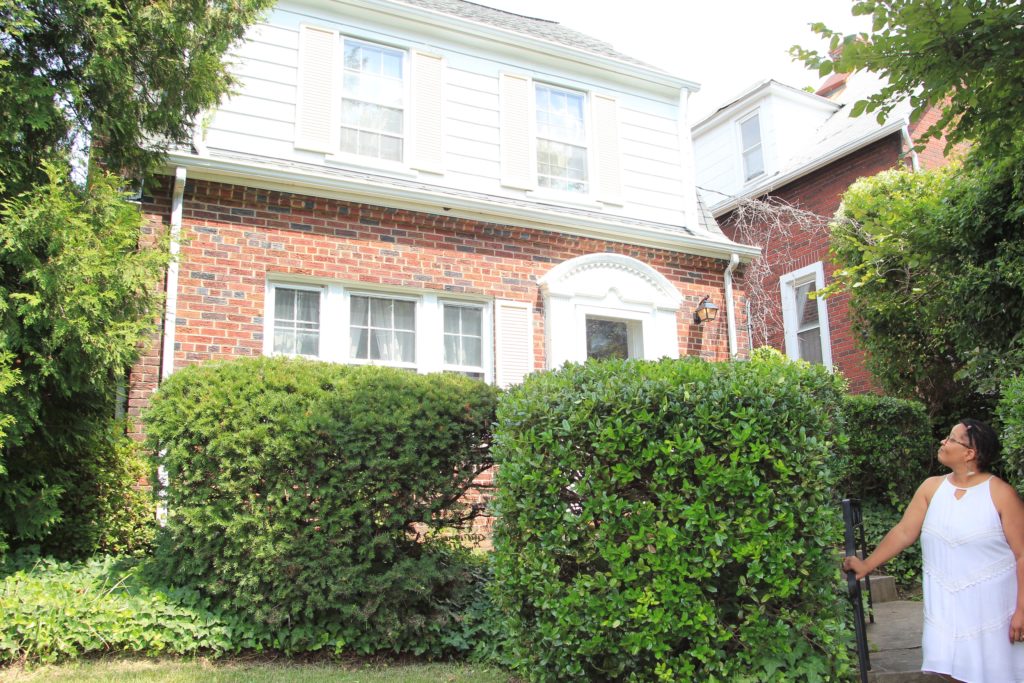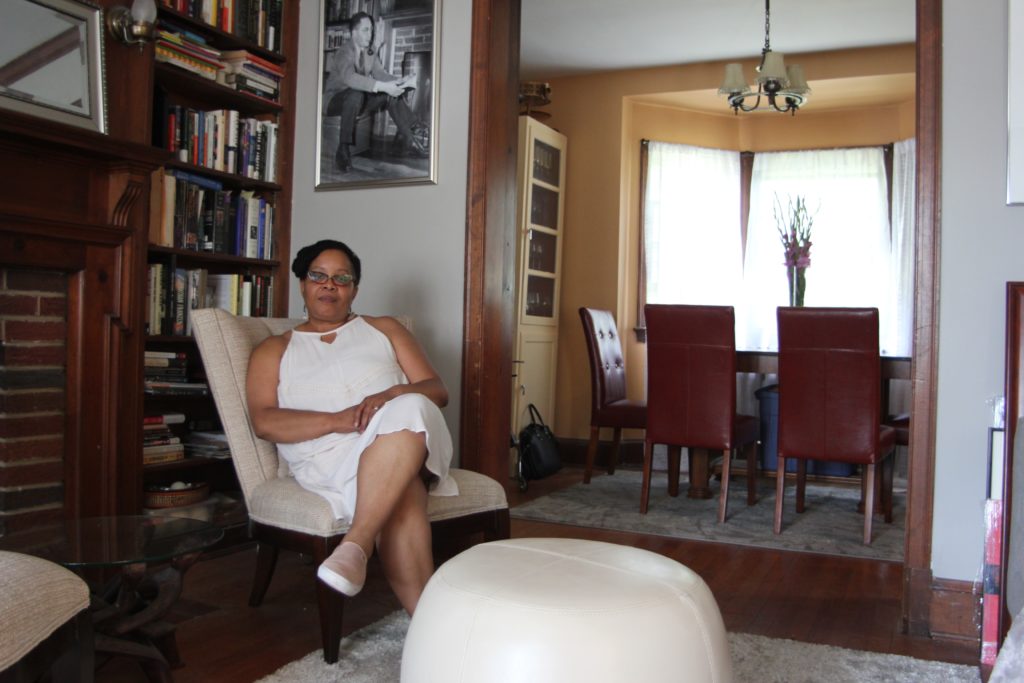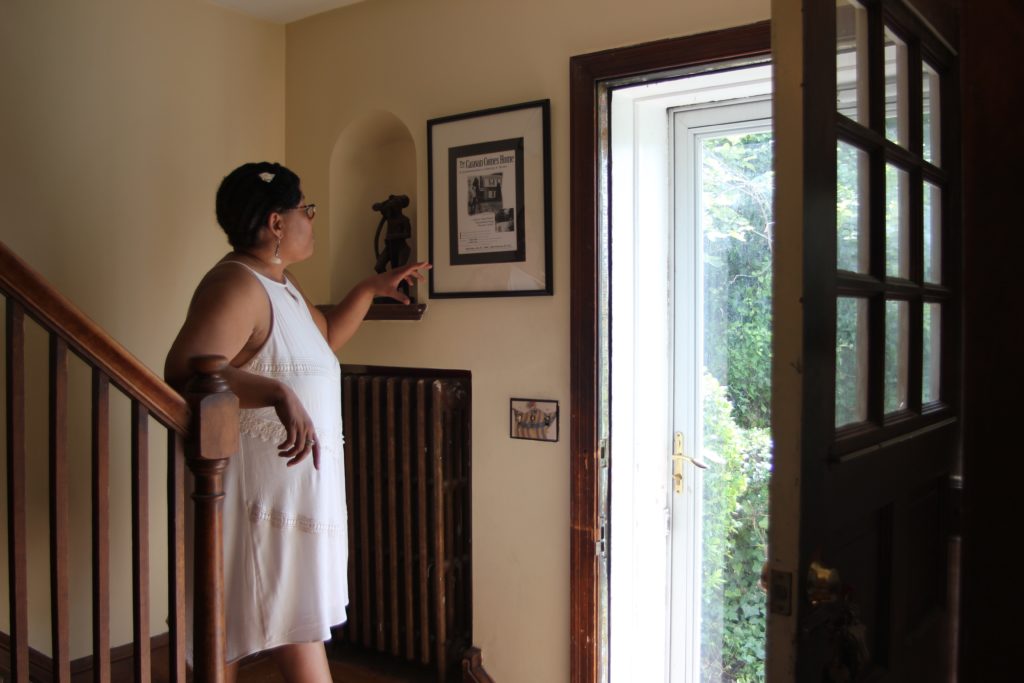For more than 20 years I have been at home in the house where Sterling Allen Brown lived. I still remember clearly the afternoon I walked into the bare living room bathed in sunlight and saw the fireplace and built-in bookcases. I still see myself, arms folded, crossing the hardwood floors to the next room and looking out a set of bay windows before turning to see that there were more book cases and more still in a small office nearby. It all so surprised me that my arms had fallen to my sides as I wondered who had lived here. They had loved books. That much I knew. With every step and every turn in the small, three-level house I could feel possibility rising in me, slow and steady, the sense that maybe, after so many houses and so many agents, this might be the one.

Marcia Davis, the current owner of the Sterling A. Brown house, Brookland neighborhood, Washington, DC. Photo by Margaret Corum.
I no longer burn with awe and anger that I found Sterling and Daisy Brown’s house sitting in Brookland, quietly for sale, no marker, no acknowledgement of its history. I guess that’s because I am here now and this part of his life is safe, no longer at much risk of being lost to the ages. Over the years, and even more lately, scholars and artists have worked to lift up Brown and insist that we recognize his pivotal contributions to African American letters and culture, which, by definition means American letters and culture. Books have been written and conferences held, a body of work is still emerging. And before you, another set of poets has come together to pay tribute with this Sterling A. Brown Tribute Issue of Beltway Poetry Quarterly.
There is a marker on the house now, actually two. The first was installed in the front yard near the steps. The artist Lou Stovall designed and hammered it into the soil himself in May 2001. The event, an effort led by poet-activist E. Ethelbert Miller, he himself an elder now, marked the centennial of Brown’s birth. I am predisposed to good parties and the breaking of bread – in that Brown and I share a thing or two, I guess – so that day was marked with a celebration. It had been the same during a housewarming several years before, and it has been so since. (The other sign sits on the wrought iron gate, declaring that the house is on the African American History Trail.)

Marcia Davis in her living room. Note the framed photo of Sterling A. Brown above her head. Photo by Margaret Corum.
Prof. Brown was known for his scholarship, his criticism, his poetry and pedagogy. His salons took place in his book-lined basement or living room, and was where he told his stories (or “lies,” as the raconteur insisted) and played his blues and jazz. Howard students like Stokely Carmichael, who would go South to fight for voting rights and build the Student Nonviolent Coordinating Committee, sought out Brown for guidance. Students like Eugenia Collier and Amira Baraka, all gone now, praised him, loved him. James Baldwin did too. Before Baldwin left for the South, he spoke to Brown, who had long established himself as the scholar-warrior. In the early days after reclaiming this house, there was something of a pilgrimage, scholars and artists came home, from Prof. John Edgar Tidwell to Prof. Joanne V. Gabbin to photographer Roy Lewis, DC’s current Poet Laureate Dolores Kendrick, writer Quincy Troupe, poet Yusef Komunyakaa. A young Ta-Nehisi Coates and Jelani Cobb and Valerie Jean and Kenneth Carroll and Joel Dias-Porter and Venus Thrash and Brian Gilmore, and so many more, crossed this threshold. Many of Cave Canem’s earliest participants found their way to Brown’s house. This, I hope, will always be a gathering place. In 2015, The Washington Performing Arts Mars Urban Arts Initiative sponsored a Brown birthday celebration that included Brown student and cultural giant A.B. Spellman, who read and shared his memories of Brown. Later that summer another group of some of Brown’s friends sat in the backyard and reminisced about his humor, his work and his kindness. Ethelbert, always making things happen, was there. He and others read and spoke.
This is a small house, but it seems to expand to fit the souls who enter. It has been both shelter and solace for me and so many others. Writers and musicians have gathered to grapple with their words in workshops or to share their melodies. The voices of poets have seeped into its walls, floated toward the sky from its backyard. How special it is then to have this chance to welcome Beltway Poetry’s Sterling Brown issue. In his essay, “The New Negro in Literature (1925-1955),” Brown wrote, “The Negro writer’s task is that of his fellows in England, France, Italy, and America; to do as honest, truthful well-designed, and revelatory work as his powers and insight permit. The rest he must leave to the future.”

Marcia Davis in her front entry hall, with the framed poster, “The Caravan Comes Home.” Photo by Margaret Corum.
Here is a piece of that future. They are poets of all ethnicities and races, diverse in experience and income and age. Brown never saw himself as part of the Harlem Renaissance. He bristled at that categorization. As he knew, the geography of African American creativity was not limited to Harlem. For him, the “New Negro” movement more accurately reflected what was emerging, a group of African American artists who refused to knuckle under racist categorization and stereotype, their goal to be recognized as fully human and to have their people portrayed and seen as such. Art is an expression of humanness, the way we make sense of this chaos, of this life. And, as I heard someone note recently, it is poetry that we call upon for the critical moments in our lives, the beginnings and endings and all that is wonderful and tragic in between.
Who knows what “Prof”– as his students, his legacy, called him – would have thought about 2017. His neighborhood would shock him, an all-white area when his family first arrived in the 1930s. Now it is churning once again, powered by gentrification. And what of the Obamas? I want to believe that maybe he would have felt the way Toni Morrison believed Baldwin would have thought about Barack Obama, that he would have loved him. I do know that he would have found an ugly familiarity in moments like Charleston and Charlottesville and all the outrageous police shootings – finally caught on camera:
They don’t come by ones
They don’t come by twos
But they come by tens
I would like to think, too, that his revolutionary spirit would be fighting to find hope. To be reminding everyone that there is still so much work to be done. He believed in the human spirit. He believed in the light of art. And though humble, he loved it when he was loved. I would like to think that he would have welcomed with open arms and delight, the words of these poets before you.
Marcia Davis is a St. Louis-born journalist who has spent the bulk of her career at The Washington Post, where she’s served on the Metro Desk, in Style and on the National Desk. On National, she edited federal government/federal worker issues, and was a leading editor on the coverage of Ferguson, MO and policing issues in the wake the fatal shooting of Michael Brown in August 2014. She currently is an articles editor and writer for The Washington Post Magazine. She edited its 2016 commemorative, award-winning issue on the National Museum of African American History and Culture. She’s also worked for the Minneapolis Star Tribune and Emerge magazine, where she served as senior editor.